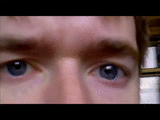A proper vision requires mammalian brains to orchestrate two important functions which occur simultaneously: visual information processing, and eye or head movements. This orchestration of sensory and motor functions requires an exquisite interaction between visual and oculomotor systems. This interaction, on the one hand, can benefit the execution of proper motor plans by using available visual inputs. On the other hand, the visual system also needs to deal with challenges caused eye or head movements: for example, head movement causes retinal slips or the motion of the visual image across large portions of the retina, which would blur our vision if not being taken care of. The ultimate goal of my lab is to identity the neural circuits underpinning the interaction of visual and oculomotor functions, and to understand the computational principles governing this biological phenomenon.
Mammalian Visual System
The optokinetic reflex happens when a person sitting in a moving train watches the motion of the external environment.
Currently, we are mainly working on two projects.
(1) When our heads rotate or the surrounding environment moves, the resulting retinal slips will be compensated by an involuntary eye movement called optokinetic reflex or OKR. Even though this reflexive behavior is drive by hardwired circuits in the brainstem, it is highly plastic. For instance, the amplitude of OKR can be adaptively potentiated when other ocular motor reflexes are impaired or in response to repetitive OKR training. This plasticity is an essential property of the OKR as it enables this fundamental behavior to be continuously readjusted to maintain image stability as the animal grows and ages. We found that the visual cortex has a profound impact on the plasticity of this innate behavior. This cortical function relies on a specific descending pathway that connects the visual cortex to the OKR circuits in the brainstem. We aim to uncover the cellular and circuitry mechanisms underlying the cortical contribution to the adaptive plasticity of OKR behavior.
(2) The brainstem is a center supporting vital physiological functions. Many brainstem nuclei mediate reflexive behaviors which are essential for animal’s survival, such as breathing, eating and escaping from dangers. In spite of the importance of the brainstem, it remains largely unknown what neuronal types make up the brainstem circuits, how they are connected, how they process sensory information or generate motor commands and how their activities lead to behavioral outcomes. To address those questions, we decide to use the OKR as the model since this behavior can be accurately quantified in our lab.

